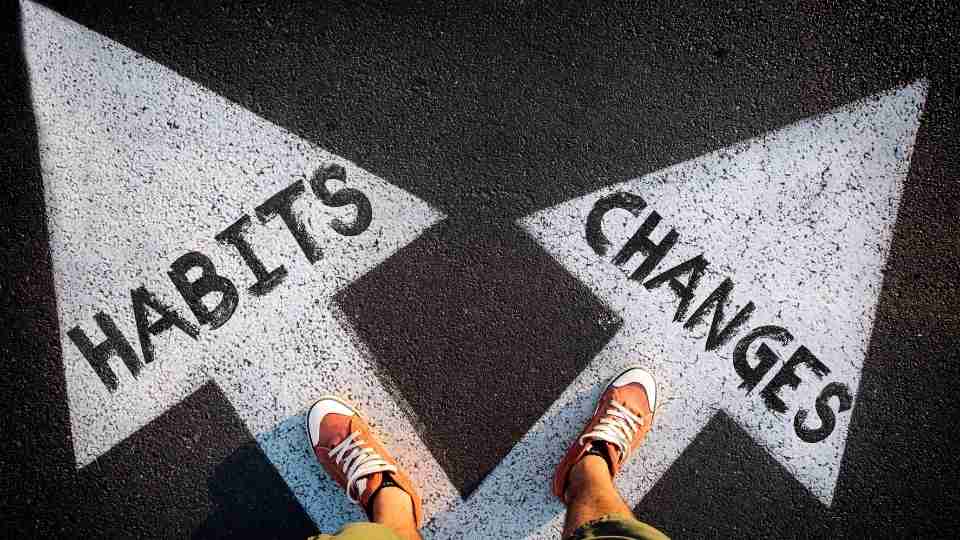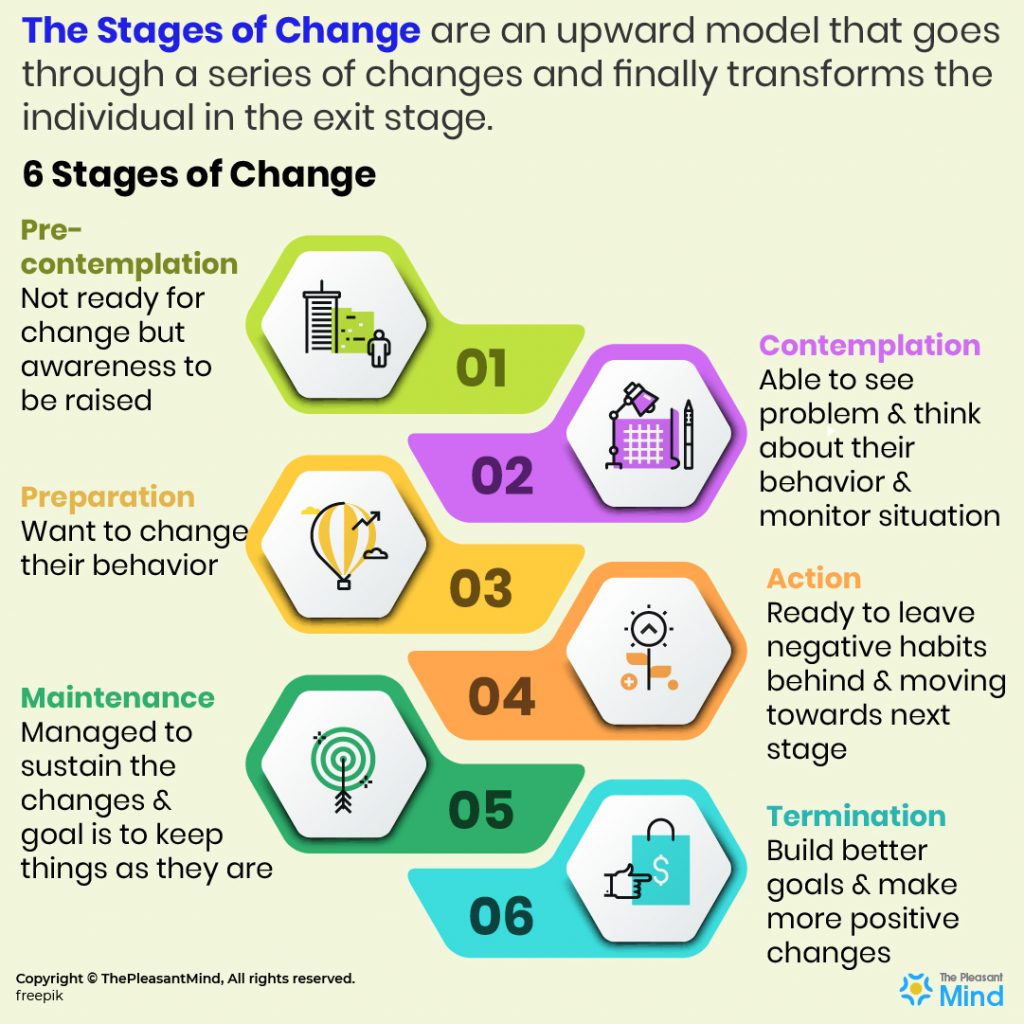
Most of us have, at some point, have decided to turn our lives around. We have tried to let go of bad habits, such as smoking, drinking, sleeping late, negative thought patterns, etc. When we try to become a better version of ourselves, we go through various stages of change.
If you are someone who has successfully turned your life around or even replaced a chronic bad habit with a good one, you know how messy the process can be. It comes with a lot of inspiration, discomfort, and effort. If they are persistent, they evolve through it all.
In fact, there is a term for it—the Transtheoretical Model or Stages of Change Model, and it comes with six definite stages, which every individual who wants to transform his behavior, goes through.
So, what are these stages? What is this model all about? Let’s find out.
Stages of Change Infographic

Understanding the Six Stages of Change Model
SUMMARY
The model was developed by James Prochaska and Carlo DiClemente. It is a model of intentional change that is needed to convert negative behavior into a positive one.
This unique model came into force around 1970, from two researchers, James Prochaska and Carlo DiClemente. Earlier, it was referred to as the ‘readiness-to-change’ model.
The study of this model was based on the observation of chain smokers, who decided to quit without any outside help.
The main outcome of smoking cessation was that if people want to quit smoking (in this case) or want to change a behavior, then the first thing is to make an intended decision.
Thus, Transtheoretical Model is concerned with intentional change. It is most effective when the individual is ready to bring about changes.
If you are someone who is struggling to change a bad habit into positive behavior, then perhaps, these six stages will help you understand your transformation better.
6 Stages of Change
The stages of change are an upward model that goes through a series of changes and finally transforms the individual in the exit stage.
In the earlier stages of this model, people aren’t very serious about applying good habits in their nature.
However, as you progress through the stages, the unhealthy behaviors take a back seat and there is an increased awareness about oneself and others.
The six stages of change are – pre-contemplation, contemplation, preparation/determination, action, maintenance, and termination. Let’s do an in-depth study of each stage.
Stage #1. Pre-contemplation
SUMMARY
This stage refers to people who are not ready for change. They may not be aware that there is a problem. It is characterized by the four R’s – Reluctance, Rebellion, Resignation, and Rationalization.
Since this is the first stage of the model, it is expected from people to not be even thinking about changing their problematic behavior. In fact, they don’t even think that there is a problem or a negative pattern in them that needs to be addressed.
This stage is often referred to as ‘not ready’ for obvious reasons. To put it simply, there is no intention of taking action to change one’s behavior.
For example, if someone is dealing with drug addiction, he or she won’t accept that their problem, unless someone else talks to him about it. It becomes a task to convince them to go to therapy or rehab.
In hindsight, the pre-contemplator also has this knowledge that he has no control over his behavior and yet he isn’t ready to accept his problem.
As per Dr. DiClemente, there are ‘the Four ‘Rs’- reluctance, rebellion, resignation, and realization. Let’s learn a bit more about them:
- Reluctance: Where the person is not aware or ready to accept the problem in his behavior.
- Rebellion: When people are deeply influenced by their behavior and rebel against anyone who tries to put a finger on his or her problem.
- Resignation: Under this, most precontemplators have given up the hope to bring a change in their behavior. Thus, they are on the verge of losing hope in them.
- Rationalization: The person in question thinks he is in complete control of his ‘problematic’ behavior and thinks that he or she has all the answers.
This stage is quite difficult to pass through, but with increasing awareness, people slowly move towards stage 2.
Stage #2. Contemplation
SUMMARY
People in this stage of change are able to understand that there is a problem. However, they may not be committed to changing. They only tend to think about their behavior and monitor their situation.
Under the contemplation stage, people are willing to acknowledge that there is a problem in them but they are not committed to changing their behavior. A possibility of change is seen in them, which is generally a good thing.
In this stage, contemplators consider the pros and cons of his or her situation, quietly monitoring their behavior. This stage can last for a few days, a month, a year, or maybe a lifetime. Many people fail to go beyond this stage.
The positive side of this stage is that people allow others to intervene in their situation and talk to them about getting help, going to therapy, or at least helping them get to the next stage of the model.
CAUTION
Fear of change can be really powerful at this stage! So, it is important to fight it off with all your willpower. You might also have difficulty balancing your priorities in life. You might also lack the courage to make such a drastic change in your life. This fear can keep you stuck in the same place for years.
Stage #3. Preparation/Determination
SUMMARY
This stage refers to people who actually want to change their behavior. They seek resources to commit to the changes and are motivated enough for changing everything from their personality to behavior.
People in this stage actually commit to changing their behavior. People intend to take action to bring changes in their lifestyle by taking small steps.
In the preparation stage, they seek out any kind of support that would help them—self-help books, medical help, therapy, etc.
Even so, there remains a need to take a meaningful step to change their usual behavior. This stage is a good time to hire a coach to make it easier for you to get to the next stage.
So, if you are feeling motivated to bring a humongous change into your personality and behavior, in a way, that will get you closer to health promotion, then you are in this stage.
Stage #4. Action
SUMMARY
The action stage refers to people who are ready to leave negative habits behind. It is largely dependent on the willpower of people. It is also a stage of flux because people in this stage are constantly moving towards the next stage.
People in the action stage start bringing changes in their lives to let go of bad behavior. Under this stage, people accept any help that would drive them away from problem behavior to health behavior.
This is considered to be the shortest stage of the model since people’s actions depend on their willpower. It can last for a year, or perhaps an hour.
People analyze and monitor their commitment to their brains and find different ways to keep themselves motivated. There is a constant change in their behavior as they slowly move towards the next stage.
TIP
At this stage, it is highly beneficial to develop a support system for yourself. Focus more on your actions than monitoring your thoughts. Celebrate even small success. Try a new thing every day. Bring as much movement in your being as possible. Plus, start listing things that you are grateful for after waking up or before sleeping.
Stage #5. Maintenance
SUMMARY
The maintenance stage refers to people who have managed to sustain the changes for over 6 months. It is considered a stage of success, and the main goal here is to keep things as they are.
Under the maintenance stage, people successfully practice their changed and healthy behaviors for about 6 months, or so. This specific stage is considered to be a complete success for individuals. The main goal of this specific stage is to maintain the status quo.
There are chances of people getting a relapse into their earlier stages. For this reason, it is important to constantly keep moving forward until their healthy behavior becomes a part of their natural persona.
They experience new things, meet new people, and try different coping strategies to not allow their brains to go back to their problematic behaviors.
NOTE
It is absolutely natural to go back and forth from one stage to another. It is also okay to regress for that will only make your willpower stronger. Do not worry and keep taking preparation action to make the behavior you want permanent. Just know when to turn to your coach, therapist, family, or friend to help you get out of this again.
Stage #6. Termination
SUMMARY
The last stage refers to not giving in to temptations. People in this stage should try to build better goals and make more positive changes in their life.
This is the last stage of the model. The ultimate goal is no more finding temptations in their early behavior. Under this stage, they are absolutely sure that they won’t turn to their negative behaviors and never let their past control them.
The best way to continue getting yourself better is to opt for building great goals and smashing them. This enhances your confidence and growth, which makes you feel good about yourself and makes you bring more positive changes in your life.
WARNING
Just because you have entered into the termination stage for more than a year or so, doesn’t mean that you have transformed completely. As per Prochaska, it’s only 20% of people who successfully make it to this stage.
It is quite possible to relapse into previous stages, even from termination. However, even if you are on the verge of touching this stage, you have made great progress.
Closing Thoughts
The most successful positive changes go through the six states of change at least four to five times in their lives, before they finally heal themselves from their bad behaviors and embrace their greatest version.
This process is in no way easy and demands a lot of energy, self-trust willpower, and patience to keep up with process. Always remember that you will fall, relapse, rewire, think of giving up, give up and try harder every day to get to the final stage of the model.
When you finally reach the endpoint of this model, you will feel great about your existence, life, and your being. This will be the reward for your months, if not years of practice.
Article Sources
1. https://web.uri.edu/cprc/transtheoretical-model/stages-of-change/
2. https://www.verywellmind.com/the-stages-of-change-2794868
3. https://psychcentral.com/lib/stages-of-change
Surabhi has a deep passion for words. She puts her heart and mind into whatever she pursues and craves for creative ventures. She has always been keen on creating original content that can make a difference. In her experience as a content writer, she has had the opportunity to work on several fields with Psychology being her favorite. Surabhi says, words have the power to transform the world, better than a sword. So she hopes to contribute her bit to this revolution. At ThePleasantConversation, she feels lucky to have the opportunity to share content capable of bringing about a change in the lives of the readers.